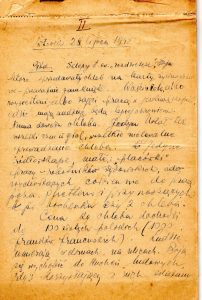Remembering the Spiritual Heroes of the Warsaw Ghetto
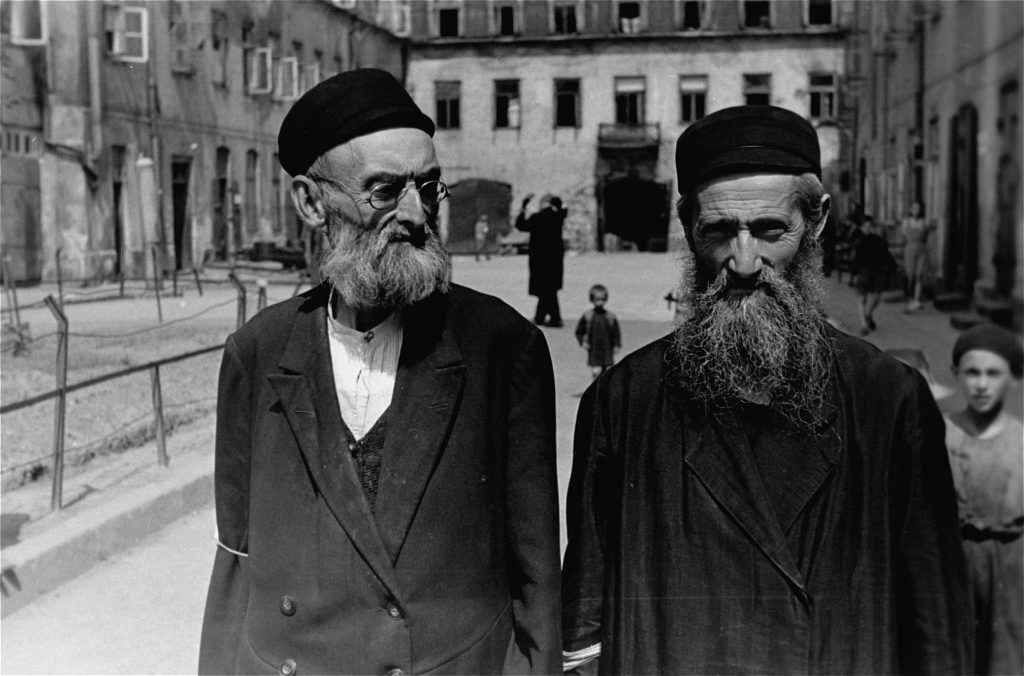
Two bearded, religious Jews walk across a courtyard in the Warsaw Ghetto. Photo: United States Holocaust Memorial Museum, courtesy of Rafael Scharf
Nestled in a farflung corner of Brooklyn, New York is the Amud Aish Memorial Museum, a relatively new Holocaust museum that takes an entirely different approach to presenting the terrifying years of 1939 to 1945. Opened three years ago under religious auspices, Amud Aish does not center on the persecution, the death machinery, and the systematic killing of our brothers and sisters. Rather, it tells a story often overlooked by so many other Holocaust museums—the story of the extraordinary spiritual strength and fortitude exhibited by thousands of victims.
Amud Aish, home to the largest archive of Orthodox rescue efforts during the war, tells a narrative of faith and spiritual resilience—a Shabbat challah cover used in the death camps; a prayer book found in the Theresienstadt concentration camp; a frayed prayer shawl worn secretly by a prisoner at Auschwitz. Writing for the online publication Tablet, Noa Gutow-Ellis, a Reform Jewish writer, was deeply moved by the museum’s radically different approach to Holocaust education: “In the DC [Holocaust] museum,” she wrote, “there are multiple displays of guns used in the Warsaw Ghetto Uprising. But when a young boy asked [the tour guide] before his Amud Aish tour, ‘Will we see guns?’ she replied, ‘No, you won’t see guns or anything scary because this is a museum about life, not death.’ Amud Aish is a Jewish museum focused on the lives of Jews during the Holocaust—not the weapons used to kill them.”
Jewish Action spoke with Rabbi Sholom Friedmann, director and CEO of the Amud Aish Memorial Museum, about the staunch faith and spiritual heroism exhibited by the Jewish heroes of the Warsaw Ghetto.
All images courtesy of the Amud Aish Memorial Museum, except where indicated otherwise.
Jewish Action: Can you explain what the term “spiritual resistance” means in the context of the Holocaust?
Rabbi Sholom Friedmann: The Warsaw Ghetto Uprising, which began on April 19, 1943 and lasted until May 16, is the example typically referred to when discussing physical resistance. In Warsaw there is a large monument, and there’s a replica of it at Yad Vashem. One side depicts the Warsaw Ghetto Uprising and the Jewish fighters surrounding Mordechai Anielewicz, the leader of the resistance. Created soon after the establishment of the State of Israel, the monument was meant to depict the new kind of Jew—the warrior who will fight for and defend the Jewish people. On the other side of the monument, there is a depiction of Jewish victims, all seemingly religious, with a rabbi holding a Torah scroll, looking downward. There, the monument represents the religious, seemingly passive Jews who went like sheep to the slaughter. The message appears to be that religious Jews tried resisting spiritually, but that wasn’t successful, whereas the Jews who resisted physically made a big mark on the history of the Holocaust.
This was the false narrative that was believed in the State of Israel for a long time. But were the religious Jews in fact passive? Were they submissive? I don’t believe so. I believe their heroism and spiritual strength were reflected in the fact that their decisions on how to respond to the Holocaust were based on a whole different set of ideas and principles. Their bravery and heroism were manifest by adhering to their religious beliefs despite the danger and the terrifying circumstances.
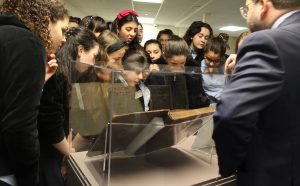
Students from the girl’s division of Yeshiva of Spring Valley in Monsey, New York looking at sefarim from pre-war Europe at an exhibit at the Amud Aish Memorial Museum.
The very term “spiritual resistance” is, however, a misnomer. Resistance implies that there are two conflicting parties with one making a demand on the other, and the other resisting the fulfillment of that demand. In the case of the Warsaw Ghetto Uprising, physical resistance refers to Jews who resisted being rounded up and deported by the Nazis. But the Orthodox Jews practicing their Judaism were not putting on tefillin or davening in Auschwitz or creating clandestine yeshivos in the Warsaw Ghetto in order to resist Nazis. To suggest that mitzvah performance is a form of resistance is simply untrue; Jews performed mitzvos because this is how they practiced Judaism. This was their way of life, what they had been trained to do no matter what the circumstances were. Orthodox Jews have always looked to Torah and to their Jewish identity for guidance, irrespective of what was going on around them.
JA: How does this museum present the story of the Uprising and the story of the Holocaust in general?
RSF: As Orthodox Jews we tend to view history a bit differently than non-Orthodox Jews. Take a look at the big, brand-name Holocaust museums: Yad Vashem in Israel and the United States Holocaust Memorial Museum in Washington. In presenting the Holocaust, both focus on the perpetrator as the end result. In other words, the Jewish experience during the Holocaust is a means to an end; the goal is to present and understand the perpetrator and the persecution that occurred. Those museums offer perspectives that are perpetrator-based. Their overriding message is: How do we prevent such atrocities from happening in the future?
More specifically, Yad Vashem’s message is “Never again!”—by educating people, we’re never going to allow this to occur again. Similarly, the US Holocaust Memorial Museum universalizes the message by addressing contemporary genocide. Its message: be an activist and stand up against injustice and intolerance.
We view the Holocaust differently. We understand that our plight in the Diaspora is that we’re going to be suffering persecution. There are going to be perpetrators who are out to destroy us: “ela shebechol dor vador omdim aleinu lechaloseinu—but in every generation they rise against us to destroy us.” That’s part of our heritage and our tradition. Of course we understand that the perpetrator must be dealt with, and we have to do whatever we can to ensure that justice is served. But as a general rule our focus is on the victim experience, not on the perpetrators; we view the perpetrator as a means to understand the Jewish experience. By learning about the kind of persecution they were facing, we understand the strength of a Jew, what kind of resilience it required to put on tefillin every day under those circumstances.
Orthodox Jews have always looked to Torah and to their Jewish identity for guidance, irrespective of what was going on around them.
The focus on the victim has always been the traditional view. Take, for example, the holiday of Pesach. How much time do we spend talking about the Egyptians as opposed to the time we spend discussing the Jewish response to the Eyptian exile? Similarly, with regard to Chanukah, very little time is spent analyzing what the Greeks were doing. We’re more interested in how the Chashmonaim responded to the persecution. Again, how much do we know about the Persians? But we know a lot about the Jewish experience during the time of the Purim miracle and how the Jews in Persia responded to the threat of extinction. We take the same approach to the Holocaust. When studying the Holocaust, we ask: How did these Jews respond and what does it mean for us? What’s the message for us? This is the traditional way of viewing our history.
In his famous work, Man’s Search for Meaning, Viktor Frankl suggests that those who survived the Holocaust
were able to do so because they found meaning in their suffering. In fact, he introduced a whole new form of psychotherapy based on the idea that people have the ability to find meaning in their suffering, which enables them to withstand it. There are others who disagree with Frankl, such as social historian Lawrence Langer, who claimed that no meaning could be found in Auschwitz. It was a situation of “choiceless choices” according to Langer—no matter what one did, he was always going to be worse off; in the death camp there was no meaning. Frankl, however, contends that there were individuals who even in the midst of such extreme despair found meaning. For the most part, Orthodox Jews brought meaning with them. Their adherence to Torah and mitzvos constituted a collective source of meaning.
JA: Are there stories illustrating spiritual heroism among secular Jews?
RSF: We have recorded testimony about non-religious Jews who, when the Nazis invaded ghettos or were destroying shuls, were the first to run and try to save the sifrei Torah; they allowed themselves to be killed with those sifrei Torah. Whether or not they identified as Orthodox, they recognized that a sefer Torah was part of their identity.
Janusz Korczak, who was not Orthodox, was quite a heroic figure in the Warsaw Ghetto. He introduced a whole new educational system—a really fascinating system. This was particularly meaningful within the Ghetto, because he was caring for children who had lost their parents and were traumatized. They needed some type of encouragement, and he saw a way to empower them through education. He had a Yiddishe heart, was deeply concerned about the children, and went to his death with them. His life could have been spared [as a doctor, he was considered valuable] but he refused to save himself and allow the children to go to their deaths without him.
JA: Some view the Uprising as a central part of the Holocaust, as it was a symbol of resistance to the Nazis and an act of heroism. This is certainly the secular Jewish view. Many religious Jews share that view as well, but there are other opinions about the Uprising, and some even argue that it was a futile attempt and may have caused more harm than good. Can you shed light on this issue?
RSF: Religious Jews always looked to halachah for guidance. The Warsaw Ghetto Uprising was no different. No doubt, there were repercussions that would occur in the event of an uprising. What doesn’t get much attention is that the Warsaw Ghetto Uprising inspired other uprisings—including an uprising at the Sobibor death camp—all of which occurred around the same period. The Nazis responded with what was known as “Operation Harvest Festival.”1 In November of 1943, close to 40,000 Jews were killed in one day as a direct response to these uprisings.
When studying the Holocaust, we ask: How did these Jews respond and what does it mean for us? What’s the message for us? This is the traditional way of viewing our history.
The Nazis made it very clear that any act of revolt would result in consequences for the others. So halachically, what was one allowed to do? These were very complicated halachic questions. And yet, we know that Rabbi Menachem Ziemba, one of the prestigious rabbinic leaders of the Warsaw Ghetto, supported the Uprising.
JA: To what degree did Torah-observant Jews participate in or cooperate with the Uprising?
RSF: That’s a difficult question. We don’t have too many records indicating how many religious people participated. I couldn’t say with any authority what the numbers were, but there clearly were Orthodox Jews who did participate. Those who did not participate were not showing signs of weakness by not physically resisting; they felt they were adhering to halachah.
JA: Can you tell us a little about the rabbinic leaders who did support the Uprising?
RSF: At one point, rabbis and the leaders in the Warsaw Ghetto (those involved in Zionist and Socialist movements and those who headed social agencies), began to debate creating a resistance to the Nazis. Rabbi Mordechai Glatstein, a young rabbi in the Ghetto who managed to survive the war and became a rabbi in Pittsburgh (we have some of his artifacts in our archives), was present at some of these meetings. A 1993 op-ed that appeared in The Jewish Chronicle of Pittsburgh, quotes Rabbi Glatstein describing those terrifying days:
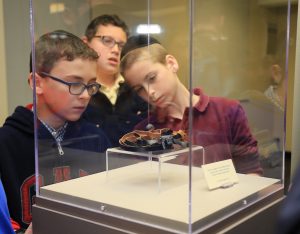
Middle school students from Yeshiva Darchei Torah in Far Rockaway, New York examining the tefillin that Mauthausen inmate Rabbi Yitzchok Avigdor used in the concentration camp from 1944 to 1945. Rabbi Avigdor served as an assistant to his father, Rabbi Yaakov Avigdor, who was the chief rabbi of Drohobycz, Poland before the war. After the war, Rabbi Avigdor was the spiritual leader of the United Synagogues of Greater Hartford, Connecticut. He died in 2010.
We had some kind of belief, hope, that the nations of the world who spoke about friendship and social honesty would come and try to help us in some way . . . When Hitler saw that other nations and their religious leaders were quiet and closed their borders to the Jews, he started the Final Solution, the destruction of European Jewry . . . . We were hiding when [the Warsaw Ghetto Uprising] started. It was organized well. I didn’t fight but instead acted as a lookout. We felt at the time that our uprising was a protest, not only against Germany but against the world. We knew we wouldn’t win, but we were able to fight back for four weeks against German armies with their tanks. France fought for only four weeks, and their entire country collapsed.
That’s a first-hand view of a religious man who participated in the Uprising.
As I mentioned earlier, Rabbi Ziemba supported the Uprising as well. A Jerusalem Post article entitled “The Last Rabbi in the Warsaw Ghetto—Zionist?,” by Eli Kavon, published in April 2013, stated the following:
In a meeting of the Warsaw Jewish leadership in January 1943, Rabbi Ziemba declared that traditional martyrdom in the face of persecution was no longer a viable response. He argued that “sanctification of the Divine Name” must manifest itself in resistance to the enemy. “In the present,” Ziemba told the ghetto leaders, “we are faced by an arch foe, whose unparalleled ruthlessness and total annihilation purposes know no bounds. Halachah [Jewish law] demands that we fight and resist to the very end with unequaled determination and valor for the sake of Sanctification of the Divine Name.”
He was stating very clearly that his view regarding the Uprising was a product of his halachic opinion. Others felt that it was not halachically correct.
JA: Esther Farbstein, a Chareidi Holocaust scholar and educator, writes in her book Hidden in Thunder: Perspectives on Faith, Halachah and Leadership during the Holocaust that the Radzyner Rebbe, Rabbi Shmuel Shlomo Leiner, “called on Jews to break out of the ghettos, flee to the forests and take up arms.” She also writes about Rabbi Shlomo Dovid Yehoshua Weinberg, the Slonimer Rebbe, who “allowed underground activists to use his basement as an arms cache” and that Rabbi Yehoshua Moshe Aaronson, who was held in the Konin labor camp, “supported a plan by the inmates to take revenge against German soldiers. ‘Let us at least defend Jewish honor and avenge our spilled blood,’ wrote Aaronson. The plan was never carried out, however, and Aaronson expressed sorrow at having missed the opportunity for vengeance and rebellion.” How would you respond to that?
RSF: It’s important to put things into context here. We’re talking about a period where we could never imagine what people were going through; however, one common thread among all the quotes [by the various rabbinic personalities in the Ghetto] is that they were all seeking Divine guidance. They were all predicating their opinion or their stance upon what they felt the Torah was dictating or guiding them to do. Those who supported forms of physical resistance felt just as strongly that halachah had room for it as those who were against it.
JA: Is there anything documented about the encouragement the resistance movement gave to the remaining Jews when they saw that they were able to defy the enemy?
RSF: We don’t have a lot of material because after the Uprising everything was destroyed. The entire Ghetto was razed to the ground.
JA: How did the situation engender unity among various groups of Jews?
RSF: It’s a good question. Often people think there were only two camps: the non-religious and the religious camps, as if the non-religious Jews were all working together. However, even amongst the resistance fighters there was a difference of opinion. There were different factions, different approaches of how to actually resist the Nazis. Some factions believed the approach should be more aggressive, others felt it should be more clandestine, some wanted more of a surprise attack, others more of an upfront attack. While it’s difficult to comment on the achdus that occurred during the Uprising, despite the different groups, I would venture to say that any situation like that is automatically going to bring people together.
The Nazis made it very clear that any act of revolt would result in consequences for the others. So halachically, what was one allowed to do?
Learning about the Holocaust engenders a certain feeling of achdus among all Jews. Because no matter how we live our lives, no matter what our religious convictions are, we all share a common experience. And I think that’s something that we see here in our museum. Even though we are focused on telling the Orthodox side of the Holocaust narrative, non-religious Jews who visit our museum are very taken by what we have to say. At the end of the day we’re all Jews, we’re all targeted and we all have what to learn from this. It’s part of our collective experience.
1. Ed. Note: On November 3, 1943, SS and police units implemented Aktion Erntefest (Operation Harvest Festival), the murder of the Jewish laborers in concentration camp Lublin/Majdanek and the forced-labor camps Trawniki and Poniatowa. Uprisings at the Treblinka and Sobibor killing centers and the Warsaw, Bialystok, and Vilna ghettos had led to increased concerns about Jewish resistance. To prevent further resistance, SS Chief Heinrich Himmler ordered the killing of surviving Jews in the Lublin District of German-occupied Poland. Most of the remaining Jews were employed in forced-labor projects and were concentrated in the Trawniki (at least 4,000), Poniatowa (at least 11,000), and Majdanek (about 18,000) camps. They were killed. At Majdanek, near Lublin, the SS shot them in large prepared ditches outside the camp fence near the crematorium. Jews from other labor camps in the Lublin area were also taken to Majdanek and shot. Music was played through loudspeakers at both Majdanek and Trawniki to drown out the noise of the mass shootings. The killing at Majdanek was the largest single-day, single-location massacre during the Holocaust [ushmm.org].
“This Is Their Story Too”
OU’s Our Way Brings Holocaust Education to Jewish Deaf
By Bayla Sheva Brenner
In the summer of 2016, Amud Aish launched a special tour for a population virtually excluded from most Holocaust museum programming—the Jewish deaf. It opened its doors to Our Way for the Deaf and Hard of Hearing, a project of the OU’s National Jewish Council for Disabilities. The tour, which focused on stories of deaf victims and survivors of the Holocaust, as well as general Holocaust education, was such a success that Amud Aish repeated it the following year and plans to do so this year as well.
“The visitors were so happy to have a tour that catered to their specific needs. It was also fulfilling on our end to provide them with this opportunity,” says Fayga Brisman, development director of Amud Aish. “After all, this is their story too.”
Rabbi Eliezer Lederfeind, founding director of Our Way and initiator of the tour, held during the “Three Weeks” summer mourning period, brought along a sign language interpreter. In addition, Rabbi Lederfeind arranged for a speaker with direct knowledge of deaf survivors.
During her presentation, the speaker spoke of her mother, a deaf survivor from Czechoslovakia.
“The participants were visibly moved by the tour,” says Miryam Gordon, program coordinator at Amud Aish. “They asked questions; they were responsive and engaged.”
Apparently, it was also an educational experience for the Amud Aish staff as well. “It was a very powerful evening for all of us,” says Gordon.
An Eyewitness Account
Dr. Hillel Seidman (1914-1995) was a researcher, author and Chassidic Jew who kept a diary chronicling daily life in the Warsaw Ghetto. Written between July 1942 and January 1943, the diary, miraculously rescued from Nazi hands, records the Ghetto’s last days. Dr. Seidman managed to escape the ghetto in January 1943, and ended up in Vittel, a prison camp in Vichy, France. He secured a false Paraguayan passport and survived the war, one of only twelve prisoners to survive Vittel. He died in 1995.
Loaned to the museum by the Seidman family, the diary provides an eyewitness account of life in the Ghetto and attests to the extraordinary spiritual heroism of those who perished. Below are excerpts from Dr. Seidman’s diary:
July 19, 1942 – Meeting of Activists and Personalities
With rumors of impending mass “resettlement” beginning again . . . a top secret meeting of activists and personalities gathered . . . the first item on the agenda was: Were the frightening rumors at all accurate? . . .The optimists argued that our strength lies in our sheer numbers. Warsaw itself is a force to be reckoned with. They would not dare destroy half a million people! Various suggestions are put forward: Maybe we should collect huge sums of money or many kilos of gold to bribe the Gestapo . . . Perhaps we should consider setting up many factories and workshops to show Jews as a productive element and thus save them from deportation. Rabbi Yosef Konigsberg . . . and Rabbi Zisha Friedman propose sending a courier to Switzerland to alert World Opinion . . . We must persuade the Pope to publicize a special appeal. We must . . . We should . . . Slowly but surely realization dawns on the gathering that all our plans are unrealistic, impossible to carry out . . .
July 21, 1942 – The Gestapo Prepares for Deportations
Crowds fight for labor cards . . . Everybody rushes back and forth seeking employment in the workshops . . . Men seek social marriage certificates to protect their wives, since there is also a rumor that those holding marriage certificates will not be deported . . . Incidentally, in the house of Rabbi Yitzchak Meir Kanal at 6 Twarda Street are also large crowds busily getting married! Bachelors who have work cards marry women who have no work, to save them from deportation. These mass marriages are conducted in great haste . . . Women still unmarried seek “husbands.” The ancient prophesy rings true: “And on that day seven women will clutch at one man saying we will eat our own bread, wear our own clothes, just allow your name to protect us” [Isaiah 4:1].
The Night of Tears
Crossing our courtyard I notice our small shtiebl. . . . About twenty men sit on upturned benches—it’s Tisha B’Av tonight! Two flickering candles at the temporary amud dimly light up the bent heads, with their eyes staring into the far distance, as that heartrending tune wells up: “Eichah . . .” the tune that was perhaps first composed at the exile from Jerusalem and has since absorbed the tears of generations . . . How true, how real those ancient lamentations read; how accurate they describe our present catastrophe. That was when it all started, when we were driven from our land and lost our sovereignty 1,872 years ago. Today is but another link in a long chain.
August 12, 1942 – Death March of Korczak’s Orphans
Today he was ordered to “vacate”
the orphanage.
Korczak himself
could really stay,
since doctors are
considered essential, and the Judenrat still retains
enough clout to save him. But
Korczak refuses
to save himself
alone. He cannot
bear to leave his
orphans and decides to accompany
them on their final journey . . . All the
children assemble in front of the orphanage on Sliska Street—so many children, from the almost adult to
the very tiny—and though they are
starved and weak they remain disciplined and well behaved . . . All eyes
follow the “doctor”; with him at their
side they feel almost safe. Korczak attends
to his children with a frightening intensity: he buttons up the coat of one child, straightens the cap of a second and adjusts the satchel of a third—then he goes up to another child and carefully wipes away his tears . . . The column of children begins to move, marching to their unknown destination . . . Who knows how much potential, skill, talent, and Jewish treasures are contained within these precious young souls, now condemned to death . . . At their head marches Janusz Korczak—the symbol of selfless love and charity overwhelmed by the cruel and evil enemy who knows no mercy.
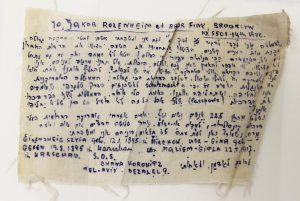
A creased piece of jacket lining that Dr. Hillel Seidman smuggled out while he was in the Vittel internment camp in Vichy, France. Dr. Seidman cut this piece from the lining of his jacket and wrote on it a desperate plea for rescue. He smuggled it out with the help of a non-Jewish woman who sent it to Rabbi Yaakov Rosenheim in New York. Written partly in Hebrew and partly in English, the note begs for passports.
August 27, 1942 – On the Death March
And so we sat—squashed, hungry, and completely cowed—all of us had surrendered to total despondency and apathy . . . Suddenly, my elderly, white-bearded neighbor with his tallis and tefillin straightened up and began to speak: at first quietly, but soon with growing strength . . . Jews, do not worry yourselves! Do not fall prey to depression or sadness. Can’t you see we are marching towards Mashiach? Can’t you see that? If only I had a glass of mashkeh, I would drink a lechaim, here and now! Lechaim Yidden!” . . . .
Hoshana Rabbah, October 2, 1942 – Torah and Avodah at One Bench
I arrive at the Schultz factory when the assembled “workers” are davening and reciting Hoshanos. The Schultz works now “employ” the cream of Orthodoxy—Chassidic rebbes, rabbanim, talmidei chachamim, religious activists, and prominent Chassidim. At one workbench, officially repairing shoes . . . sits Rabbi Aryeh Zvi Frumer, formerly rosh yeshivah at Chachmei Lublin. He might be sitting here but his mind is miles away; his lips are constantly moving, obviously he is studying Torah by heart. Every so often, he throws a question to his neighbor opposite, Rabbi Kalonymus Kalmish Shapira of Piaseczno, author of the Chovos HaTalmidim, and they begin a whispered dialogue in Talmudic study quoting Chazal and posekim. The spirits of the Rishonim and Acharonim hover above this workbench—for these “shoemakers” are really geonim and Talmudic giants. Who worries about the German overseers or the SS? Rapidly, they forget the continual hunger, the ongoing persecution and oppression, the ever-present threat of death. They are no longer in a factory at 46 Nowolipie Street, but inside the Temple’s Hewn Chamber at a sitting of the Sanhedrin. While some succumb to their maltreatment, these gedolim rise to new spiritual heights . . .
January 14, 1943
I remember one famous Chassidic Rebbe once said why the Bais Hamikdash was built on Mount Moriah rather than Mount Sinai. A place where a Jew had been moser nefesh was more important than the site where the Torah was revealed. And where else had so many Jews fallen al kiddush Hashem than these roads of the Warsaw Ghetto? Every street is a Mount Moriah, every stone an akeidah. If, by some miracle, I survive this madness, perhaps I should bring a stone from Nalewki Street to Eretz Yisrael and place it alongside the Kosel Maaravi. When Jews come on pilgrimage to that sacred site, they could also weep over this stone for the loss of all their loved ones, for the destruction of a large segment of Klal Yisrael. They will bewail the extinction of a central powerhouse in Judaism—Polish Jewry—as they mourn the churban of the holy Temple.
[The final entry] January 18, 1943—The First Resistance
Nobody puts any trust in German documents and permits. Instead they stow away anywhere they can—in lofts, bunkers, and hiding places . . . A unit of ZOB (Zydowska Organizacja Bojowa— the Jewish Resistance Organization) lives at 7 Wolynska Street. When the Latvians and Ukrainians approach the building, a few hand grenades are thrown at them from the windows. A number of them are killed, including their SS officer. They immediately panic and run blindly in all directions. An eerie silence descends on the street. Yet all know this cannot last, the Germans won’t give up so easily. The Resistance instructs all Jews to leave the street immediately, and everybody evacuates the area. As darkness falls, a few SS arrive. They proceed down the street holding electric pocket torches, which they shine at every apartment entrance as they pass . . . There is no hope, no escape, nowhere to hide. And the merciless enemy seeks to destroy everything.
Text courtesy of the Seidman family.

